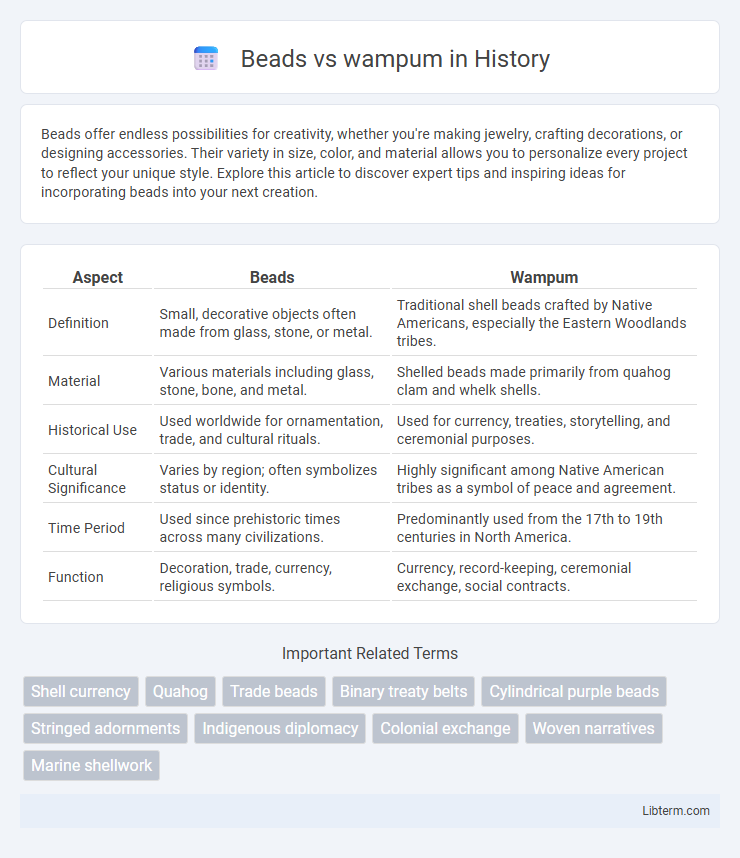Beads offer endless possibilities for creativity, whether you're making jewelry, crafting decorations, or designing accessories. Their variety in size, color, and material allows you to personalize every project to reflect your unique style. Explore this article to discover expert tips and inspiring ideas for incorporating beads into your next creation.
Table of Comparison
| Aspect | Beads | Wampum |
|---|---|---|
| Definition | Small, decorative objects often made from glass, stone, or metal. | Traditional shell beads crafted by Native Americans, especially the Eastern Woodlands tribes. |
| Material | Various materials including glass, stone, bone, and metal. | Shelled beads made primarily from quahog clam and whelk shells. |
| Historical Use | Used worldwide for ornamentation, trade, and cultural rituals. | Used for currency, treaties, storytelling, and ceremonial purposes. |
| Cultural Significance | Varies by region; often symbolizes status or identity. | Highly significant among Native American tribes as a symbol of peace and agreement. |
| Time Period | Used since prehistoric times across many civilizations. | Predominantly used from the 17th to 19th centuries in North America. |
| Function | Decoration, trade, currency, religious symbols. | Currency, record-keeping, ceremonial exchange, social contracts. |
Introduction to Beads and Wampum
Beads are small, decorative objects often made from glass, stone, or plastic, used for personal adornment and artistic expression across numerous cultures. Wampum consists of traditional shell beads crafted by Indigenous peoples of the Eastern Woodlands in North America, serving as currency, storytelling tools, and symbols of social status. Both beads and wampum carry deep cultural significance, but wampum uniquely embodies historical and ceremonial importance within Native American societies.
Historical Origins of Beads and Wampum
Beads trace their historical origins to ancient civilizations across Africa, Asia, and the Americas, serving as decorative, cultural, and trade objects for thousands of years. Wampum, specifically crafted from white and purple shell beads, originated with Indigenous peoples of the Northeastern Woodlands, notably the Haudenosaunee, as a tool for recording treaties, storytelling, and ceremonial purposes. While beads broadly represent diverse materials and functions worldwide, wampum holds distinctive cultural and political significance rooted in Indigenous American history.
Cultural Significance of Wampum
Wampum holds profound cultural significance among Indigenous tribes of the Northeastern United States, serving as a symbol of social status, historical record, and spiritual communication. Unlike ordinary beads, wampum belts are meticulously crafted from purple and white quahog shells and used in treaty ceremonies, storytelling, and legal agreements. This sacred artifact embodies collective memory and identity, making it an enduring emblem of Indigenous heritage.
Traditional Uses of Beads
Beads have been traditionally used across cultures for personal adornment, spiritual rituals, and as symbols of status and identity. Unlike wampum, which primarily served as currency and treaty-making tools among Native American tribes, beads were integral in crafting jewelry, clothing embellishments, and ceremonial objects. Their symbolic meanings often varied, representing protection, social rank, or cultural heritage in indigenous and ancient societies worldwide.
Material Differences: Beads vs. Wampum
Beads are typically crafted from a variety of materials such as glass, wood, metal, or plastic, allowing for diverse shapes, colors, and textures. Wampum, in contrast, specifically consists of cylindrical beads made from quahog or whelk shells, prized for their white and purple hues. The unique shell origin of wampum not only defines its material composition but also imbues it with cultural and historical significance among Indigenous peoples of the Northeastern Woodlands.
Symbolism and Meaning in Native Cultures
Beads in Native cultures often symbolize personal identity, spiritual beliefs, and social status, with colors and patterns conveying specific meanings within tribes. Wampum, made from shell beads, holds profound cultural significance as a medium of diplomatic treaties, historical record-keeping, and sacred ceremonies, particularly among Eastern Woodlands tribes. Both beads and wampum serve as powerful symbols of heritage, communication, and continuity in Indigenous societies.
Beads and Wampum in Trade and Economy
Beads and wampum served as critical mediums of exchange in Indigenous trade networks across North America, with wampum--crafted from shell beads--holding particular cultural and economic significance among Eastern Woodlands tribes. Wampum belts functioned not only as currency but also as symbols of agreements and social status, facilitating complex trade transactions and diplomatic relationships. The economic value of beads varied regionally, influencing trade routes and the distribution of goods such as furs, tools, and food resources in pre-colonial and colonial markets.
Artistic Techniques: Crafting Beads and Wampum
Beads and wampum differ significantly in artistic techniques; beads are typically crafted from materials like glass, stone, or metal using methods such as cutting, polishing, and drilling to create various shapes and sizes. Wampum, traditionally made from the purple and white shells of the quahog clam and whelk, requires meticulous hand-carving and drilling to produce cylindrical beads that are then strung into belts or strands. The distinct craftsmanship of wampum involves symbolic patterns conveying cultural narratives, whereas bead-making emphasizes decorative versatility across diverse cultures.
Modern Interpretations and Uses
Modern interpretations of beads and wampum emphasize their cultural and artistic significance in Indigenous communities. Beads are widely used in contemporary jewelry, fashion, and art to symbolize identity and heritage, while wampum retains ceremonial and historical importance, often representing treaties and storytelling. Both materials have evolved from traditional roles to become powerful symbols of resilience and cultural expression in present-day contexts.
Conclusion: Comparing Beads and Wampum
Beads and wampum both serve as significant cultural artifacts, with beads often used for personal adornment and trade across diverse global societies, while wampum holds a specific ceremonial and diplomatic importance among Indigenous peoples of the Eastern Woodlands. Wampum strings and belts are uniquely crafted from quahog and whelk shells, symbolizing treaties, storytelling, and political agreements, highlighting their function beyond mere decoration. The comparison underscores beads' widespread decorative and economic roles contrasted with wampum's specialized symbolic and communicative purpose in Indigenous governance and heritage.
Beads Infographic

 libterm.com
libterm.com